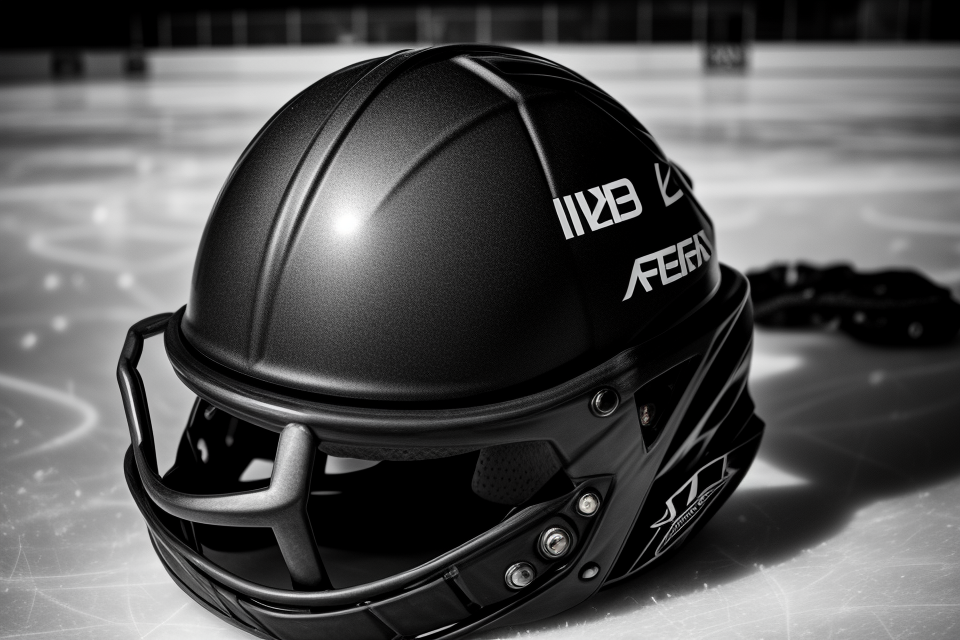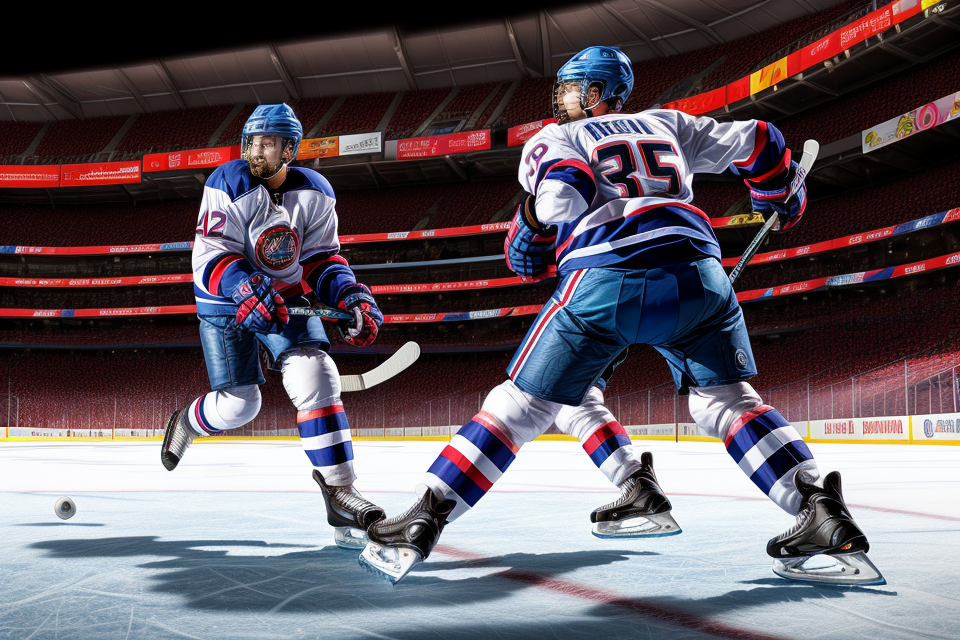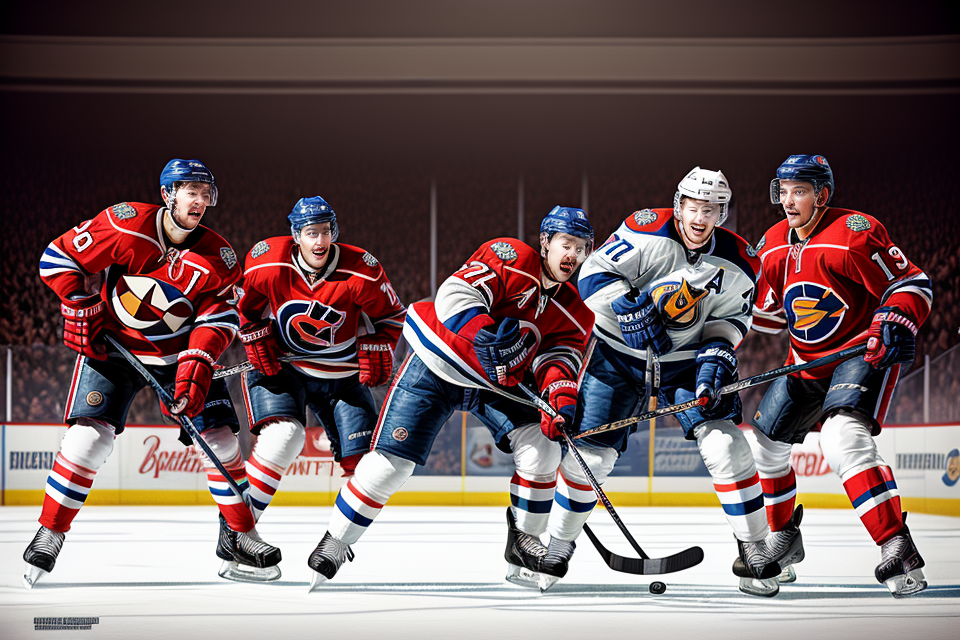Hockey is a physically demanding sport that requires players to wear protective gear, including helmets, to prevent injuries. But how long can a hockey helmet last before it needs to be replaced? In this article, we’ll explore the lifespan of a hockey helmet and how to determine when it’s time to retire your helmet. Whether you’re a casual player or a professional athlete, understanding the lifespan of a hockey helmet is crucial for staying safe on the ice. So, let’s dive in and find out how long a hockey helmet is good for.
The lifespan of a hockey helmet can vary depending on factors such as the quality of the helmet, the frequency of use, and the level of impact it sustains. On average, a hockey helmet can last anywhere from 1 to 5 years before it needs to be replaced. It’s important to regularly inspect your helmet for any signs of wear and tear, such as cracks or dented areas, and to replace it if you notice any damage. Additionally, helmets should be replaced after any significant impact, such as a fall or a collision on the ice. Following these guidelines can help ensure that you stay safe and protected while playing hockey.
Factors Affecting the Lifespan of a Hockey Helmet
Materials Used
Advantages and Disadvantages of Different Materials
The materials used in hockey helmets can have a significant impact on their lifespan. The choice of materials can affect the helmet’s durability, weight, and overall protection. In this section, we will explore the advantages and disadvantages of different materials used in hockey helmets.
Plastic vs. Fiberglass
Plastic and fiberglass are two commonly used materials in hockey helmets. Plastic helmets are typically lighter and more affordable than fiberglass helmets. They are also more flexible and can absorb more impact energy, which can reduce the severity of a blow to the head. However, plastic helmets may not provide as much protection as fiberglass helmets, and they may not be as durable.
Fiberglass helmets, on the other hand, are generally more expensive than plastic helmets. They are also heavier and less flexible, but they provide better protection against impacts. Fiberglass helmets are also more resistant to wear and tear, which means they may last longer than plastic helmets.
Carbon Fiber vs. Kevlar
Carbon fiber and Kevlar are two other materials that are sometimes used in hockey helmets. Carbon fiber helmets are lightweight and strong, and they provide excellent protection against impacts. However, they can be expensive and may not be as durable as other materials.
Kevlar helmets are also lightweight and strong, but they are less expensive than carbon fiber helmets. They are also more resistant to wear and tear, which means they may last longer than carbon fiber helmets. However, Kevlar helmets may not provide as much protection against impacts as carbon fiber helmets.
Overall, the choice of materials for a hockey helmet will depend on the individual’s needs and preferences. It is important to consider factors such as cost, weight, protection, and durability when choosing a hockey helmet.
Usage and Wear and Tear
Normal Wear and Tear
- Signs of Normal Wear and Tear
- Cracks and Dents
- A small dent or a crack on the helmet does not necessarily mean that it is no longer safe to use. However, if the dent or crack is large enough to affect the helmet’s structural integrity, it is essential to replace the helmet immediately.
- Discoloration
- Discoloration of the helmet is a normal sign of wear and tear. It occurs when the helmet is exposed to the sun for an extended period. While discoloration does not affect the helmet’s performance, it may impact its aesthetic appeal.
- Loose or Missing Components
- Over time, the components of the helmet may become loose or even fall off. This is a sign that the helmet needs to be replaced. Some components, such as the chin strap or the visor, are essential for safety, and if they are not functioning correctly, the helmet is no longer safe to use.
- Cracks and Dents
Extreme Conditions
- Signs of Extreme Condition Damage
- Heat Damage
- Prolonged exposure to high temperatures can cause the helmet to warp or become deformed. This can compromise the helmet’s structural integrity and make it unsafe to use.
- UV Damage
- Exposure to the sun’s UV rays can cause the helmet’s materials to degrade over time. This can weaken the helmet and affect its performance.
- Chemical Damage
- Exposure to chemicals, such as cleaning solvents or fuel, can cause damage to the helmet’s materials. This can weaken the helmet and affect its performance.
- Heat Damage
In conclusion, the lifespan of a hockey helmet depends on various factors, including usage and wear and tear. It is essential to regularly inspect the helmet for signs of normal wear and tear and extreme condition damage. If any of these signs are present, it is crucial to replace the helmet to ensure safety on the ice.
Maintenance and Storage
Importance of Proper Maintenance
Maintaining a hockey helmet is crucial to ensuring its longevity and effectiveness. Neglecting regular maintenance can result in a decrease in the helmet’s protective capabilities and an increased risk of injury.
Cleaning and Disinfecting
Cleaning and disinfecting the helmet is a critical aspect of maintenance. Dirt, sweat, and other debris can accumulate on the helmet’s surface, leading to bacterial growth and odor.
Recommended Cleaning Agents
Several cleaning agents can be used to clean a hockey helmet, including:
- Mild soap and water
- Isopropyl alcohol (70% or higher)
- Helmet cleaning solutions specifically designed for sports helmets
Precautions When Cleaning
When cleaning the helmet, it is important to:
- Avoid using abrasive materials, which can scratch the surface of the helmet
- Dry the helmet thoroughly to prevent mold and mildew growth
- Never use harsh chemicals or solvents, as they can damage the helmet’s materials
Replacing Components
Over time, components such as the face mask, chin strap, and padding may wear out or become damaged. Replacing these components is necessary to maintain the helmet’s integrity and protective capabilities.
Types of Components to Replace
Components that should be replaced regularly include:
- Face mask
- Chin strap
- Padding
- Strap attachments
Frequency of Replacement
The frequency of component replacement depends on several factors, including the helmet’s age, the frequency of use, and the level of play. As a general guideline, it is recommended to replace components every 1-2 years.
Storing the Helmet
Proper storage of the helmet is essential to maintain its shape and prevent damage. Improper storage can cause the helmet to deform or become misshapen, reducing its effectiveness.
Tips for Proper Storage
When storing the helmet, it is important to:
- Place it in a cool, dry location, away from direct sunlight
- Keep it in its original box or a protective case
- Avoid stacking or storing helmets on top of each other
- Never hang the helmet by the straps, as this can cause damage to the shell
By following these maintenance and storage guidelines, hockey players can extend the lifespan of their helmets and ensure their continued protection on the ice.
Safety Standards and Certifications
Types of Certifications
- CSA Standard: The CSA standard, also known as the Canadian Standards Association standard, is a set of guidelines that ensure that hockey helmets meet minimum safety requirements. This standard is specific to Canada and is overseen by the CSA Group, a non-profit organization that writes and administers standards for a wide range of products.
- Snell Standard: The Snell Memorial Foundation is a non-profit organization that focuses on the development and promotion of safety standards for a variety of sports, including hockey. The Snell standard for hockey helmets is a set of requirements that helmets must meet in order to be certified for use in competitive play.
- EN Standard: The EN standard, or European Norm standard, is a set of safety requirements for helmets used in various sports, including hockey. This standard is widely recognized and respected, and many hockey helmets sold in Europe and around the world are certified to meet the EN standard.
Importance of Compliance with Safety Standards
- Adherence to safety standards is crucial for the protection of players, as it ensures that helmets provide adequate protection against impacts and other hazards associated with hockey.
- Compliance with safety standards is often mandatory for players at all levels of competition, from amateur to professional.
- Failure to comply with safety standards can result in penalties, including fines and suspension, and can also have legal implications.
Penalties for Non-Compliance
- Non-compliance with safety standards can result in penalties for both players and teams.
- Players who wear helmets that do not meet safety standards may be disqualified from play or face other penalties, such as a penalty shot or a minor penalty.
- Teams may also face penalties, such as fines or loss of points, for failing to ensure that their players are using properly certified helmets.
Legal Implications
- In some cases, failure to comply with safety standards can have legal implications, particularly in cases where a player is injured while wearing a helmet that does not meet safety standards.
- Liability for injuries sustained in hockey games can be complex, and it is important for players, teams, and leagues to be aware of their legal obligations when it comes to safety equipment.
- Players and teams may be held liable for damages if it can be proven that they failed to use properly certified equipment, including helmets, and that this failure contributed to the injury.
Determining the End of a Helmet’s Lifespan
Visual Inspection
Visual inspection is a crucial step in determining the end of a hockey helmet’s lifespan. Regular examination of the helmet can help identify any signs of wear and tear that may indicate the need for replacement. Here is a checklist for visual inspection:
Checklist for Visual Inspection
Examining the Outer Shell
The outer shell of the helmet is the first line of defense against impacts and should be inspected thoroughly. Look for any signs of cracks, dents, or scratches on the shell. Also, check for any loose or missing parts, such as decals or clips.
Examining the Inner Liner
The inner liner of the helmet should also be inspected for any signs of wear and tear. Check for any tears, holes, or discoloration in the liner. Also, make sure that the liner is still attached to the helmet and is not loose or separated from the outer shell.
Examining the Visor (if applicable)
If the helmet has a visor, it should also be inspected for any signs of damage. Check for any cracks, scratches, or discoloration on the visor. Also, make sure that the visor is still securely attached to the helmet and does not rattle or move when the helmet is shaken.
By following this checklist, you can ensure that your hockey helmet is in good condition and is safe to use. Remember, it is always better to replace a helmet before it shows signs of wear and tear to ensure maximum protection on the ice.
Performance Testing
Types of Performance Testing
Impact Testing
Impact testing is a crucial aspect of determining the lifespan of a hockey helmet. It involves subjecting the helmet to various impacts to assess its ability to absorb and disperse energy. There are two main types of impact testing: static and dynamic.
- Static impact testing: This type of testing involves applying a known force to the helmet using a mechanical device. The force is typically applied to the front, side, and rear of the helmet to simulate impacts from different directions. The helmet’s ability to prevent penetration and absorb energy is then evaluated.
- Dynamic impact testing: This type of testing simulates the helmet’s interaction with a moving object, such as a puck or a player’s head. The helmet is attached to a headform that moves at a specified velocity and angle to simulate a realistic impact. The helmet’s ability to prevent penetration and absorb energy is then evaluated.
Penetration Testing
Penetration testing is another type of performance testing that assesses the helmet’s ability to prevent penetration of the head from an impact. This testing involves shooting a projectile, such as a puck or a metal ball, at the helmet at a specified velocity and angle. The helmet’s ability to prevent penetration and absorb energy is then evaluated.
Retention Testing
Retention testing is designed to assess the helmet’s ability to stay in place during play. This testing involves subjecting the helmet to various movements and impacts to simulate the conditions of a hockey game. The helmet’s ability to remain in place and prevent slippage is then evaluated.
In conclusion, performance testing is an essential part of determining the lifespan of a hockey helmet. It helps to ensure that the helmet is functioning optimally and providing the necessary protection to the player. By conducting regular performance testing, players and parents can ensure that their helmets are in good condition and ready for the next game.
Replacing a Hockey Helmet
Factors to Consider When Buying a New Helmet
Size and Fit
How to Measure Your Head
Properly measuring your head is crucial to ensuring a comfortable and secure fit. The following steps will guide you through the process:
- Place a tape measure around your head: Start at the crown of your head and wrap the tape measure around your head, keeping it level and parallel to the floor. Make sure the tape measure is snug but not too tight.
- Mark the measurement: Use a pen or pencil to mark the tape measure where it overlaps. This will be your head circumference.
Size Charts
Size charts vary by brand, so it’s essential to consult the specific brand’s size chart when purchasing a new helmet. Generally, they will list sizes in centimeters (cm) or inches (in). It’s important to remember that size charts are a general guide, and your helmet should fit snugly for maximum protection.
Brands to Consider
When looking for a new helmet, consider reputable brands known for their quality and performance. Some popular brands include:
- Bauer
- CCM
- Easton
- HockeyMonkey
- True
Common Pitfalls in Sizing
Common pitfalls in sizing include purchasing a helmet that is too large or too small, or not considering the additional protection options available. It’s essential to remember that a helmet that is too loose can come off during play, while a helmet that is too tight can cause discomfort and impair vision.
Tips for a Proper Fit
When trying on a helmet, ensure it fits snugly and does not rock back and forth on your head. A proper fit should be comfortable, with no excess room at the temples or back of the neck. If the helmet feels too loose, try a smaller size or consider additional protection options to ensure a secure fit.
Features and Additional Protection
When purchasing a new helmet, consider the additional protection options available. These include face protection, neck protection, and ear protection. Each type of protection offers unique benefits and can help to reduce the risk of injury during play.
Types of Additional Protection
Some popular types of additional protection include:
- Visors: Visors are a popular choice for face protection, offering excellent visibility and eye protection.
- Facemasks: Facemasks provide more comprehensive face protection, covering the entire face and reducing the risk of cuts and bruises.
- Neck Guards: Neck guards provide added protection to the neck and can help prevent injuries to the spine.
- Ear Pads: Ear pads offer extra protection to the ears, reducing the risk of ear injuries during play.
Types of Face Protection
Face protection options include visors and facemasks. Visors are a popular choice for players who want to maintain their visibility on the ice while still enjoying comprehensive face protection. Facemasks offer more comprehensive coverage, protecting the entire face from impacts and reducing the risk of cuts and bruises.
Types of Neck Protection
Neck protection options include neck guards and neck braces. Neck guards are a popular choice for providing added protection to the neck and spine. Neck braces offer more comprehensive support, reducing the risk of neck injuries during play.
Types of Ear Protection
Ear protection options include ear pads and ear covers. Ear pads offer extra protection to the ears, reducing the risk of ear injuries during play. Ear covers provide a more comprehensive solution, offering added protection to both the ears and the temple area.
Importance of Additional Protection
Additional protection options can significantly reduce the risk of injury during play. While a standard helmet provides excellent head protection, additional protection options can help to safeguard the face, neck, and ears from impacts and collisions.
Price and Quality
When purchasing a new helmet, it’s essential to balance price and quality. Reputable brands offer excellent performance and durability, but they often come with a higher price tag. Quality checks
Final Thoughts and Recommendations
While the lifespan of a hockey helmet can vary depending on factors such as usage, maintenance, and manufacturing quality, it is important to know when it’s time to replace your helmet for your safety on the ice. Here are some final thoughts and recommendations to keep in mind when it comes to replacing your hockey helmet:
- Always prioritize your safety by wearing a helmet that meets the appropriate safety standards and guidelines.
- Be aware of the signs that indicate your helmet may need to be replaced, such as visible damage, fading or discoloration, and cracks or splits in the foam or shell.
- Schedule regular check-ups for your helmet and perform self-inspections before each game or practice to ensure it is in good condition.
- Consult with your equipment manager, team coach, or a trusted sports retailer for guidance on choosing a new helmet that meets your needs and preferences.
- Consider the fit, comfort, and performance of the helmet, as well as any additional features or accessories that may enhance your safety and performance on the ice.
- Don’t rely solely on visual inspections and instead, consider investing in a helmet with an attached sensor or smart technology that can detect impacts and alert you to potential damage.
- Be prepared to spend a little more money on a high-quality helmet to ensure your safety and peace of mind on the ice.
- Finally, always remember that the decision to replace your helmet ultimately depends on your personal judgment and discretion, so trust your instincts and prioritize your safety above all else.
Encouraging Safe Hockey Play
One of the primary reasons to replace a hockey helmet is to encourage safe hockey play. As previously mentioned, helmets are designed to withstand impacts from pucks and sticks, but they are not indestructible. Over time, even the toughest helmets will begin to show signs of wear and tear, and their ability to protect the player will diminish.
It is essential to understand that while a helmet may not appear damaged on the outside, it may still be compromised on the inside. Internal components, such as the foam lining, can become compressed or damaged, which can significantly reduce the helmet’s effectiveness. This is why it is crucial to replace a helmet even if it looks undamaged.
By encouraging players to replace their helmets regularly, the sport of hockey can become safer for everyone involved. It is essential to ensure that players have the proper equipment to protect themselves from injuries. Additionally, when players replace their helmets, they can ensure that they are using the latest technology, which can help prevent injuries and enhance performance.
Another benefit of encouraging players to replace their helmets regularly is that it helps promote a culture of safety within the sport. When players see their teammates and opponents replacing their helmets regularly, it sends a message that safety is a priority in hockey. This can help reduce the stigma associated with wearing protective gear and encourage more players to take safety seriously.
In conclusion, encouraging players to replace their helmets regularly is essential to ensuring the safety of everyone involved in the sport of hockey. By promoting a culture of safety and providing players with the latest technology, hockey can become a safer and more enjoyable sport for all.
FAQs
1. How long is a hockey helmet good for?
A hockey helmet is typically good for around 5-10 years, depending on how often it is used and how well it is maintained. The helmet should be inspected before each use for any signs of wear or damage, and should be replaced if it shows any signs of cracking, splitting, or other damage. It is also important to replace the helmet if it has been involved in a collision or if it has been subjected to any impact that could have caused damage.
2. What are the signs that a hockey helmet needs to be replaced?
There are several signs that a hockey helmet may need to be replaced, including visible cracks or splits in the shell, a significant amount of wear on the foam liner, or any damage to the helmet’s face mask or other components. Additionally, if the helmet has been involved in a collision or subjected to any impact that could have caused damage, it should be replaced even if it appears to be in good condition.
3. Can a hockey helmet be reconditioned or resurfaced?
In some cases, a hockey helmet may be able to be reconditioned or resurfaced to extend its lifespan. This typically involves repairing any damage to the shell or liner, and may also include repainting or re-decaling the helmet. However, it is important to note that reconditioning or resurfacing a helmet may not always be possible, and may not always provide the same level of protection as a new helmet. It is best to consult with a certified helmet repair technician or the manufacturer to determine if reconditioning or resurfacing is an option for your helmet.
4. How can I maintain my hockey helmet to extend its lifespan?
To help extend the lifespan of your hockey helmet, it is important to properly maintain it. This includes storing the helmet in a cool, dry place when not in use, avoiding exposing the helmet to extreme temperatures, and avoiding any modifications or add-ons that could compromise the helmet’s integrity. It is also important to clean the helmet regularly to remove any dirt or debris that could cause damage to the foam liner or other components. Finally, always inspect the helmet before each use to ensure that it is in good condition and free from any damage.



